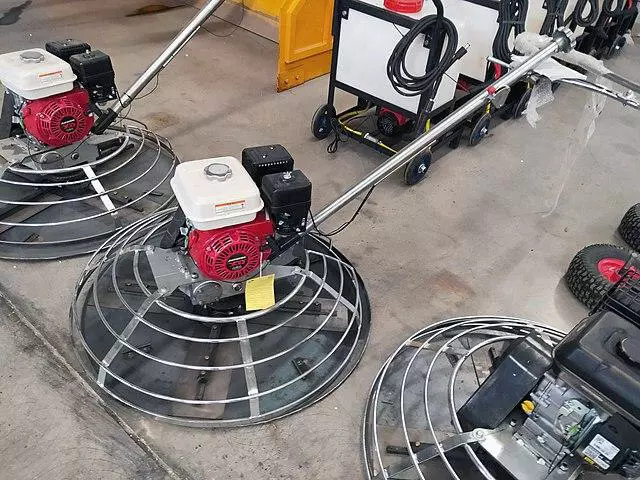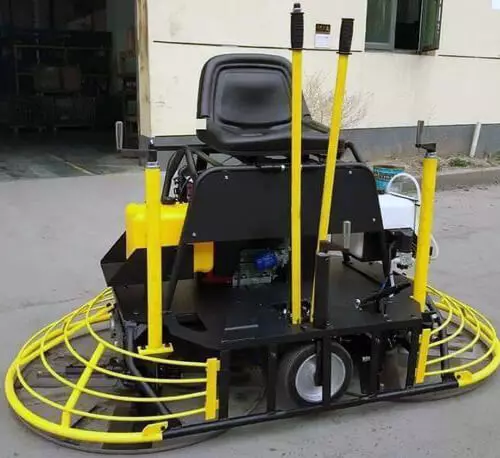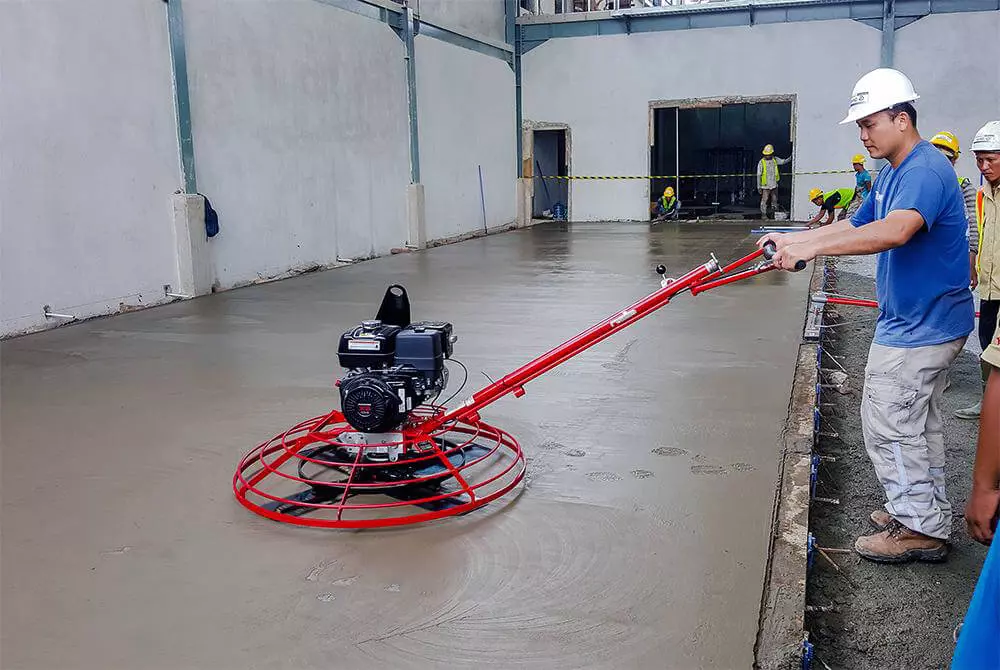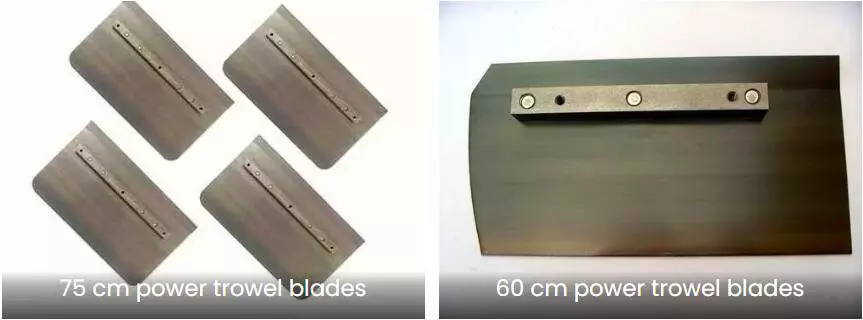09Nov 2022
table of contents
A trowel is a machine for obtaining a smooth, dense and level surface on flat concrete areas.
At the bottom of the machine, there are one or two rotating sets of adjustable steel blades. Usually, the machine rotates at about 150 rpm, and its function is to smoothen the already set concrete.
Trowel machines contain propeller-shaped blades that polish and smooth concrete surfaces through the rotational motion of these propellers.
Concrete trowels also known as power trowels contain an engine located at the centre of gravity where the blades or propellers are, providing greater stability and balance.
Concrete finishing is an essential step that you can't miss in concrete laying and paving. Refining concrete involves levelling, compacting, and otherwise treating the surface of fresh or recently poured concrete to achieve the desired effect.

Trowel Machines
There are many types of concrete finishing equipment available. The two most widely used are ride-on trowels and walk behind power trowels.
Ride-on
Walk-behind
The working principle of these two trowels is the same. The only difference is how they operate.
As the name suggests, the ride-on trowel is to ride on it. The trowel blade is mounted under the operator's seat.

Ride-on trowels
Ride-on trowels are only cost-effective when completing large concrete floors since the operator sits on the machine, they save time and labour.
Ride-on trowels are easy to control thanks to their steering system. Since they do not require much effort, operators can be more efficient.
Ride-on trowels are easier to operate than walk-behind machines. Due to innovations and developments, the market is flooded with power-assisted models with hydraulic and electronic steering. The new model includes advanced features such as a torque converter and shifting clutch.
They are used on floors, patios and concrete paths for a superior finish. Not only are they heavier, more expensive and difficult to transport, but they are also quite expensive. Because defects on the finished surface are easier to spot with a walk-behind trowel, some operators prefer walk-behind machines to ride-on models. The finished surface must therefore be corrected on the next pass.
In the case of walk-behind trowels, the operator walks behind the trowel and manipulates it by applying force with both hands. Both types can be powered by a gas engine or an electric motor.

Walk-behind trowels
Walk-behind trowels are ideal for places where a ride-on model cannot be used easily. These places include protrusions and near the edge of a surface.
They are lighter and hence easier to transport. The lighter weight also allows finishers to reach concrete surfaces faster than a heavier ride-on machine. Some refinishers prefer manual models because they will enable them to see the surface better.
But on the other hand, walk-behind trowels require a lot of force to push, which makes them harder to operate and takes more time to complete. However, in this case, the operator can see how the concrete is done and immediately correct any mistakes. These machines are less expensive but can still produce the same quality finish.
Also, the walk-behind trowels have a much smaller engine as only one rotor needs to be powered. A walk-behind machine is more than a simple machine. This is a machine with a lot of features, like a closed transmission and shock-absorbing handles.
Make sure to check the following things before starting any type of concrete power trowels;
Engine oil level
The water level of the tank
Pump oil level
Level of a fuel tank
The condition of the trowel arm and blade
Air filter to see if they are in the right condition or not
fittings and hoses should be checked for any leaks
Check for grease points
Step 1. Ensures that the operator is sitting in a position that is comfortable for them. Then turn on the engine, hold the key switch, and keep doing it until the engine starts.
Step 2. Pull out the choke control knob if the engine is cold. Even a warm engine may require opening the choke. Starting the engine for more than 5 seconds will damage the starter. If the engine does not start, release the key and wait 10 seconds before starting the engine again.
Step 3. Before operating the trowel, allow the engine to warm up.
Step 4. Firmly press the accelerator pedal to activate the trowel.
Step 5. To get the most out of your ride-on trowel, it should drive in the direction the operator is facing. This enables the operator to see the slab's surface smoothed as clearly as possible while completing the largest area. The machine should make a 180° U-turn to reach the end of the slab and continue straight.
Step 6. The speed of the ride-on trowel can be controlled by "feathering" the left joystick forward and backwards while controlling the right joystick.
Step 1. As soon as the engine of the trowel is started, the blade will start rotating.
Step 2. You can increase the speed by adjusting the throttle control on the handle.
Step 3. The blade should now start spinning on the floor. By adjusting the throttle control, you can change the speed of the blades.
Step 4. The blade of the trowel should now be moving so you can feel the steering of the scoop. By pressing the unit's handle, you can move it to the right. After this, the trowel should move slightly to the right.
Step 5. If you want to move the trowel to the left, lift the handle of the trowel slightly. This is how the trowel is used.
Step 6. After operating it more often, you can gauge how much pressure you need to boot the device. The way the trowel operates varies by surface type. You may need to get used to it on wet concrete before you feel comfortable on hard concrete. Working with dry concrete feels very different from working with wet concrete.
BISON manufactures two types of electric trowels - commercial and pro-Series. These series are available in 36" or 46" options and accomplish the same tasks for contractors.
There are some differences between the commercial and pro series:
Chrome ring vs painted ring
Rider Gearbox vs Walk behind Gearbox
Spider Assembly
Three years of manufacturing compared to 1 year of warranty
The design and technology of these electric trowel series are the same. Both series are of exceptionally high build quality. The Commercial Series rivals any other standard electric trowel on the market. The Pro Series is the only hand-push electric trowel on the market with a ride-on trowel transmission for increased performance and reliability.
In addition to the size of the surface to be treated, there are two fundamental aspects to consider when choosing a trowel machine.
To determine which blade diameter is the best, we need to know what kind of work needs to be done.
The optimal blade diameter size for small surface jobs should be between 60 and 65 cm.
However, when troweling large surfaces, the optimal diameter should be 90/95 cm or even 120/125 cm.
We're talking about a riding electric trowel, and we're going to get better performance on such large surface jobs.

Two sizes of electric trowel blades
We can also distinguish between electric and gas-powered trowels according to the project's needs.
Electric trowels are mostly chosen when an internal combustion engine cannot be used due to specific requirements.
For this reason, gas engines are the most common. They make levelling concrete easier because they are more robust and don't require cables.
You can also find gas trowels and even automatic ones.
The weight of the trowel is a significant consideration, as weight is not just about ease of lifting. It's about how early you can start finishing and the type of finish you need.
Lightweight trowels
Typically, lighter machines are preferred for residential concrete, such as for house and shed slabs. This is because contractors often don't have access to lifting equipment to move machines safely, and the lighter the machine, the sooner you can start finishing.
Heavy-duty trowel machine
Heavier machines are better for burnt trimming or trimming slabs in hot conditions. Concrete surfaces in hot conditions. It dries very quickly and requires heavier machines to "break" the surface to finish the concrete. Heavier machines tend to cut through any "bumps" created during finishing, while lighter machines may bounce on them.
The difference between light and heavy machines usually comes down to two apparent factors, machine size and engine size. The larger the machine's size, the heavier it is. The bigger the engine size, the heavier it is.
So, if you want a lightweight machine, go for a decent size and a smaller engine. If you are looking for a heavy-duty machine, try to go for a bigger machine with a bigger engine. If you want a smaller, heavy-duty machine, go for a smaller machine with a bigger engine.
Manual steering is typically used for small to medium trowel rides. Once you move up for larger machines, you may need to consider Hydraulic steering, especially if you are considering a larger machine for panning.
While manual steering is cheaper and less complicated to use, it requires more effort to operate when moving. If you are planning to use manual steering for a long time, this will stress the operator's upper body.
The hydraulic steering system puts all its energy into steering the machine while the hydraulic system steers it for you. But remember that hydraulic steering adds at least $10,000 to the machine's price.
A common mistake contractors make is buying the biggest machine, only to find it unsuitable for their job.
If you purchase a trowel machine for the first time, we recommend a smaller machine that can both pan and finish.
Once you are comfortable with the unit, you may consider pairing it with a larger dedicated finishing machine to increase fleet and capacity.
While some manufacturers offer different size ranges, the following sizes are typical for most major brands:
24" (600mm) | Usually with a swivel/edging ring |
30" (750mm) | Usually with swivel/edging |
34" (850mm) | |
36" (900mm) | |
40" (1000mm) | |
46" (1150mm) | |
48" (1200mm) | As far as we know, the BISON 48" Riding Trowel is the only true 48" Trowel machine. |
Size generally refers to the width of the machine. The type of work you plan to do will affect the size you may need. There are no set rules for what size machine is best for what works, but here are our recommendations:
The choice between diesel and gas engines is easy. Gas engines are the most common and generally do not affect the machine's performance.
Due to its lower emissions, diesel is only required when operating in confined spaces such as tunnels and mines. However, diesel engines add considerable expense and weight to the machine.
Contrary to what you might think, a bigger engine size doesn't mean it spins faster. It means it has more power, more precisely horsepower. The larger the trowel, the larger the motor required to turn the blade. Since larger engines are heavier, they have more weight, which is ideal in some applications.
Ease of maintenance and repair is an important consideration, as mechanical failure can happen during operation. Maintaining your machine should be hassle-free. Things to look for include:
Does the machine have sealed bearings?
Are there lubrication points on the base/spider?
Does the blade arm have an adjustment bolt?
Will the trowel ring prevent contact with the blade during operation?
Does the engine come from a well-known manufacturer?
What is the trowel machine used for?
A trowel machine is a piece of lightweight construction equipment used by construction companies and contractors to smooth concrete while it’s still in wet condition.
What is a concrete finishing machine?
The concrete finishing machine finishes the concrete surface with a smooth, rough, broom, texture or stipple finish while the concrete is still in a plastic state. These devices for concrete surface treatment are used worldwide for different requirements and aesthetic appearances.
How does the electric trowel move?
Move both handles to the forward position to move the machine forward. Moving the two levers to the rear position moves the power trowel backwards. Moving the right handle to the left moves the machine to the right, and moving the right handle to the right moves the device to the left.
Why do we plaster concrete?
Every time concrete is poured, troweling is crucial because it allows the concrete to continue the finishing process of the concrete and squeeze the residual water out of the concrete. Removing excess moisture from concrete reduces the chance of concrete cracking.
How to choose the best electric trowel?
Flatness is a crucial consideration for concrete surfaces. Without the right machinery and expertise, achieving tolerable ground flatness can be a challenge. For the perfect finish, consider searching the various trowels on the market.
Power trowels level concrete by floating and trimming. Floating involves removing bumps, filling valleys and compacting concrete simultaneously. Finishing creates a hard and smooth outer surface by further flattening the slab.
The trowel selection process can be confusing because so many models from different brands exist. You must consider your requirements to get the best machine for your project.
Fields of application of electric trowels
There is no one-size-fits-all when it comes to buying an electric trowel. Many concrete manufacturers own at least one electric trowel, but they sometimes have to rent something else with a different function.
Site visits may prevent contractors from using Ride-on trowels. Another approach might be to use multiple push-pull electric trowels to finish the job on time.
However, most workplaces require both types. Using a trowel will conquer most floor slabs, but a trowel will be best when going around obstacles like pipes and narrow doorways.
For example, the 24-inch diameter walk-behind electric trowel is ideal for working along edges, small doorways, and around pipes. On the other hand, trowels with a 46-inch diameter can handle medium to large dumps with a wide coverage of all floor types.
The dual 36-inch overlapping rides can do a commendable job if you're finishing small to medium floors. Consider a 46-inch or 60-inch machine with non-overlapping blades for best results on large concrete floors.
FF and FL Ratings
The F-number system rates floors for smoothness and smoothness. The correct machine and proper troweling technique are critical to achieving acceptable FF and FL values.
A hydraulic ride-on trowel is recommended for high FF in large commercial jobs. This machine offers an excellent horsepower-to-weight ratio for maximum slab flatness.
The ride will reach the highest possible FF value. Use a counter-rotating ride-on trowel if you want to move along the edge without overlapping effects.
The BISON trowel machine is designed for the upper and lateral smoothing of prestressed concrete slabs. With the technology used by this machine, the product has a better finish and, since it manages to eliminate surface defects, it stands out among those made without the use of the machine.
This machine allows the use of products of different sizes without further preparation. Just changing the lateral moving parts and adjusting the height of the trowel. A hopper mounted on the machine allows a continuous supply of mortar specially designed to improve the surface finish of the workpiece. In addition, it allows you to add topcoats of different colours or different aggregates to achieve different finishes.
In the BISON trowel, the position of the trowel is adjustable, enabling the final height of the product to be adjusted in an easy way and with complete precision. The side parts can be opened hydraulically for easy placement and removal of the machine on the casting bed without damaging the moulded product. Thus making the most of the 100% manufactured product.
Both the machine feed rate and the trowel feed rate can be easily adjusted for optimum productivity and finish.
In conclusion, in this article, we have discussed two types of trowel machines that differ in their steering mechanisms. Ride-on trowels use engine power to steer, while walk-behind trowels steer by pushing them by hand.
With a ride-on trowel, large areas can be done quickly. But with limited visibility, it can be challenging to check the quality of the finish.
Quality is maintained with the walk-behind trowels, but it's a bit laborious to use them in larger areas. So it's totally up to you which type you need for your project.
Both types are easy to operate and can be powered by a gas engine or an electric motor. Product costs may vary depending on the manufacturer.
If you are considering purchasing a trowel, we recommend you consult an expert first. Get in touch with our team by clicking here or filling out the contact form on this page.
inquiry form here
BISON BLOG, All the latest news and views from Bison Machinery.